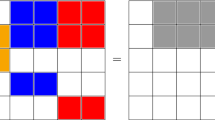Abstract
We consider in this paper solutions for TU-games where it is not assumed that the grand coalition is necessarily the final state of cooperation. Partitions of the grand coalition, or balanced collections together with a system of balancing weights interpreted as a time allocation vector are considered as possible states of cooperation. The former case corresponds to the c-core, while the latter corresponds to the aspiration core or d-core, where in both case, the best configuration (called a maximising collection) is sought. We study maximising collections and characterize them with autonomous coalitions, that is, coalitions for which any solution of the d-core yields a payment for that coalition equal to its worth. In particular we show that the collection of autonomous coalitions is balanced, and that one cannot have at the same time a single possible payment (core element) and a single possible configuration. We also introduce the notion of inescapable coalitions, that is, those present in every maximising collection. We characterize the class of games for which the sets of autonomous coalitions, vital coalitions (in the sense of Shellshear and Sudhölter), and inescapable coalitions coincide, and prove that the set of games having a unique maximising coalition is dense in the set of games.
Similar content being viewed by others
References
Albers, W. (1974). Zwei Lösungskonzepte für kooperative Mehrpersonenspiele, die auf Anspruchsnivaus der Spieler basieren. OR-Verfahren/ Methods of Operations Research, XVIII, 1–8.
Albers, W. (1979). Core- and kernel-variants based on imputations and demand profiles. In O. Moeschlin & D. Pallaschke (Eds.), Game theory and related topics. Amsterdam: North-Holland.
Bejan, C., & Gómez, J. C. (2012a). Using the aspiration core to predict coalition formation. International Game Theory Review, 14(01), 1250004.
Bejan, C., & Gómez, J. C. (2012b). Axiomatizing core extensions. International Journal of Game Theory, 41(4), 885–898.
Bennett, E. (1983). The aspiration approach to predicting coalition formation and payoff distribution in sidepayment games. International Journal of Game Theory, 12(1), 1–28.
Berge, C. (1959). Espaces topologiques. Paris: Dunod.
Bondareva, O. (1963). Some applications of linear programming methods to the therory of cooperative games. Problemy Kibernetiki, 10, 119–139.
Cesco, J. C. (2012). Nonempty core-type solutions over balanced coalitions in tu-games. International Game Theory Review, 14(03), 1250018.
Cross, J. (1967). Some economic characteristics of economic and political coalitions. Journal of Conflict Resolution, 11, 184–195.
Derks, J., & Peters, H. (1998). Orderings, excess functions, and the nucleolus. Mathematical Social Sciences, 36(2), 175–182.
Gillies, D. (1953). Some theorems on \(n\)-person games. PhD thesis, Princeton, New Jersey.
Gillies, D. (1959). Solutions to general non-zero-sum games. Contributions to the Theory of Games, 4, 47–85.
Gonzalez, S., & Grabisch, M. (2015). Preserving coalitional rationality for non-balanced games. International Journal of Game Theory, 44(3), 733–760.
Grabisch, M., & Miranda, P. (2008). On the vertices of the \(k\)-additive core. Discrete Mathematics, 308, 5204–5217.
Guesnerie, R., & Oddou, C. (1979). On economic games which are not necessarily superadditive: Solution concept and application to a local public good problem with few a agents. Economics Letters, 3, 301–306.
Kannai, Y. (1992). The core and balancedness. In R. J. Aumann & S. Hart (Eds.), Handbook of Game Theory, Chap. 12 (pp. 355–395). North-Holland: Amsterdam.
Peleg, B., & Sudhölter, P. (2003). Introduction to the theory of cooperative games. New York: Kluwer.
Shapley, L. S. (1967). On balanced sets and cores. Naval Research Logistics Quaterly, 14, 453–460.
Shellshear, E., & Sudhölter, P. (2009). On core stability, vital coalitions, and extendability. Games and Economic Behavior, 67, 633–644.
Sun, N., Trockel, W., & Yang, Z. (2008). Competitive outcomes and endogenous coalition formation in an n-person game. Journal of Mathematical Economics, 44, 853–860.
Turbay, G. (1977). On value theories for n-person cooperative games. PhD thesis, Rice University, Houston, TX.
Zumsteg, S. M. (1995). Non-Cooperative Aspects of Cooperative Game Theory and Related Computational Problems. PhD thesis, Eidgenossischen Technischen Hochschule Zurich.
Author information
Authors and Affiliations
Corresponding author
Additional information
We wish to thank Peter Sudhölter for his helpful comments.
Rights and permissions
About this article
Cite this article
Gonzalez, S., Grabisch, M. Autonomous coalitions. Ann Oper Res 235, 301–317 (2015). https://doi.org/10.1007/s10479-015-1951-0
Published:
Issue Date:
DOI: https://doi.org/10.1007/s10479-015-1951-0



